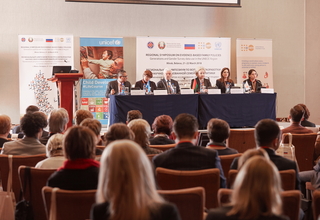Older age at marriage, growing number of divorces, and wide occurrence of new forms of union - the experts of the UN Population Fund Resource Centre spoke about the main family change trends.
Why does the mean age at marriage increase?
Experts point out that currently less and less people enter their first marriage at an early age, and there are slightly more marriages in the older age group. According to the Census of 2009 the age at first marriage for women was 24.2, and for men - 26.4 years, while in 1999 these figures were 22.8 and 25 respectively.
The increased mean age at marriage is directly related to the social changes and the development of the economy. Firstly, women now have equal rights with men, which made it possible for them to realize their potential both in the family and at work. Secondly, there have been some structural changes in the economy: there has been an increase in the services sector and the decrease in industrial production; lifetime contracts are being replaced with short-term contracts and competitive selection of highly skilled professionals. Stricter requirements for specialists and an increased competition have correspondingly changed the attitudes of young people: to achieve professional fulfilment they now allot more time for education and advanced training.
According to Peter McDonald, Professor of Demography of the Australian National University, the change in the economy has caused growth in the living standard, which led to the increased material needs and economic ambitions of youth on the whole. “Because of their desire to meet employer's requirements and ensure a certain standard of life young people spend more time developing their human capital, which automatically postpones the decision about starting a family”, the expert says.
Another factor contributing to the increased mean marriage age is the growing number of divorces. So, in 2012 there were 512 divorces per each 1000 marriages, while in 2011 there were 445 divorces. That is why young people try to be more careful in choosing their partner, which puts off the decision of starting a family.
Still, according to Sergey Zakharov, a Russian researcher, the increase in divorce numbers does not necessarily has a negative effect on the number of marriages and birth rate in a country.
“A larger proportion of divorcees remarry and have children. And if we talk about birth rate, the likelihood of having another child for any of the partners is higher in the second marriage than in the first, where the relationship has gone bad”, the analyst explains.
Both men and women usually remarry when they are 30-39 years old. In 2011 this age group accounted for 37-38% of remarriages among men and women. Men aged 40-49 remarry more frequently than their younger counterparts. In 2011 twenty-five per cent of all bridegrooms were 40-49 years old; there are less women marrying at this age: they accounted for 20% of all brides the same year.
It should be noted that divorced men virtually of any age remarry more actively than enter their first marriage. However, widowers are less eager to marry again. With women the situation is slightly different. Almost all figures for widows and divorced women are lower than for men. Divorced women remarry more than men only at the age of 25. Widows rarely remarry.
Psychologist: There will always be trial marriages
Older mean age at marriage and more divorces have led to the emergence of alternative forms of union. During the period from 1999 to 2009 the share of couples living together has grown almost by 1.5 times – from 3.5% to 5.1% for men, and from 3% to 4.2% for women.
The society has also become more tolerant towards premarital cohabitation, which is reflected in the wide occurrence of families living together unmarried.
When talking about alternative forms of union Natalia Taran, psychologist, remarked, “Most people living together permanently formalize their partnership over time, as this reduces the number of problems related to inheritance, acknowledgement of children and suchlike. Still, there will always be trial marriages, where the couple initially start from the premises “Let us try living together, if it does not work, we will go different ways, there is nothing to keep us together”.
The research conducted by Russian experts has demonstrated that 29% of all married couples lived together before marriage.
As a result of the increased number of unregistered families within the last decades in Belarus the number of children born to women not married officially has been growing fast. Nowadays every fourth or fifth child in the country is born outside a registered marriage. Still, experts remark that not all children born outside a marriage are children of single mothers. A considerable part of them is children born in a de facto family where the union has not been formalized.
Older age at marriage, more divorces, wide occurrence of new forms of union, growing number of extra-marital births – all these trends are due to the changes in the structure of the economy, improved living standard and a different attitude to a family. Nowadays the younger generation have to make more efforts to fulfil professionally, which directly influences the age at marriage. Trying to minimize the risk of a divorce, couples prefer alternative forms of union.
To better understand the dynamics of a modern family and the trends characterizing its development and change, respective sociological surveys of the population are needed. The data obtained will be of interest not only for the research community – it will be useful in developing a more effective and meaningful family policy.
Statistical comparison of Belarusian families in 1999 and 2009
| 2009 | 1999 | |
|---|---|---|
| Age at first marriage | Bride — 24.2 years Bridegroom — 26.4 years |
Bride — 22.8 years Bridegroom — 25 years |
| Share of unregistered marriages | 8% | 5% |
| Share of children born outside a registered marriage | About 20% | About 18 % |
| Number of children in a family | 67% families with children raise one child 27% - two 6% - three and more |
58% families with children raise one child 36% - two up to 5% - three and more About 20% children outside marriage |
| Divorce to marriage ratio | 78,800 marriages and 47,300 divorces registered (ratio is 1.6) |
71,994 marriages and 35,100 divorces registered (ratio is 2.05) |
For details please contact Volha Herasenka, Communications Assistant, UNFPA Belarus, mobile: 8 029 178 67 00




